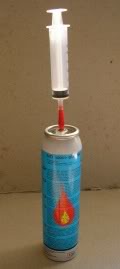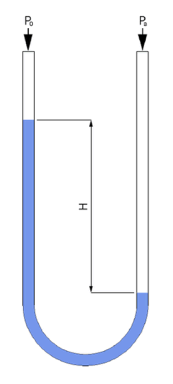Fuel meter
A fuel meter, also known as a propane meter, is used to inject a predetermined amount of fuel gas (usually propane) into the chamber of a combustion or hybrid. Any system that injects a known volume of fuel into the gun is a fuel meter. Fuel meters can take a couple of different basic forms.

Syringe based meter
The simplest and cheapest fuel meter is a syringe. The syringe is filled from a propane (or butane) tank by inserting the syringe tip into a suitable sized piece of hose fitted over the tank outlet. When the tank valve is opened the syringe plunger will move back. The tank valve is closed when the correct amount of fuel is in the syringe. The syringe is removed from the hose and the excess pressure in the syringe is released to the atmosphere. The syringe now contains the measured volume of fuel at atmospheric pressure. The fuel is injected into the gun's chamber using a needle passed through a small port, or between the clean out adapter and clean out plug. Plastic syringes up to about 60cc are available from well supplied farm supply stores since the syringes are used to give medicines to farm animals. Expect to pay about $2 for a 60cc plastic syringe and perhaps another $1 for a blunt tip needle. Smaller syringes frequently come with printer cartridge ink refill kits.
syringe fuel meter video tutorial
There are several ways to attach a syringe to a propane or butane source:
 |
 | |||
 |
 |
 |
Ball valve + pressure regulator based meter
More complex fuel meters consist of an adjustable pressure regulator and pressure gauge, connected to two ball valves with a length of pipe in between. The volume of this pipe and the pressure of the gas determines the amount of gas injected. The second ball valve is connected to the chamber of the gun. A fuel meter is operated as follows:
- The regulator is set to a predetermined pressure for the particular meter and chamber size
- The ball valve closest to the regulator is opened, filling the pipe up until the second ball valve with gas at the regulated pressure
- The first ball valve is closed again, closing off the section of pipe between the two valves
- The second ball valve is opened, the pressurized gas inside the meter expands and enters the main chamber
- The second ball valve is closed, and the cannon is ready to fire
The regulator usually only needs to be set the first time, and further fueling can be done simply by opening and closing the two ball valves. A fuel meter provides fast and very consistent fueling, and is the easiest way to use bottled gas for fuel.
It is possible to construct a fuel meter using only a meter pipe, pressure gauge, and two ball valves (with no regulator). This type of meter is less expensive and will provide accurate fueling, but is not as easy to use as a meter setup with a regulator.
Calculations
Constructing a fuel meter and determining the correct pressure to use requires a few calculations. First you need to calculate the fuel:air ratio, and from that the amount of fuel needed. These calculations are covered under stoichiometry.
Formulas for fuel meters:
P=pressure in bar, Vf=fuel volume, Vm=meter volume. Any unit of measurement can be used for the volume, as long as the same unit is used throughout. Pressure needs to be converted to bar, if you have the pressure in psi divide it by 14.7.
- P = Vf/Vm
- Vm = Vf/P
- Vf = P*Vm
Concrete example
In the example from the stoichiometry article, we found that the fuel volume needed for a 3000 cc chamber is 126 cc. At 1 atmosphere (14.7 psi) of overpressure, we'd need a meter volume of 126 cc. At twice the pressure, we'd need half the volume and so on.
For the example, we decide that meter pressure will be 3 bar. The meter volume required is then 126/3 = 42 cc.
The Fuel Tool (found on Burnt Latke's performance calculators page) automates the fuel meter calculations.
Needle Valve plus Pressure Gauge

Another type of fuel meter is simply a needle valve and a low range pressure gauge. The needle valve can be the valve and very small outlet hole in a typical Bernzomatic torch head.
The needle valve is plumbed to the chamber as is the low pressure gauge. To protect the torch and gauge it is a good idea to plumb both through a single small ball valve. To use, the ball valve is opened. Then the needle valve is opened a small amount. When the pressure in the chamber has risen 4% the two valves are closed. Assuming an atmospheric pressure of 14.7 PSI, adding 4% propane will raise the pressure in the chamber by 0.59 PSIG. Since the pressure rise is small, standard 120 or 250 PSIG gauges won't work for this type of meter.
A possible replacement for a low pressure range gauge is a "U-tube manometer". In this type of pressure gauge the pressure is related to the difference in height of the two columns of liquid. If the U-tube is filled with water, then a 1" difference in height represents a 0.0361 PSI difference in pressure. So, 0.59 PSI would be a 16.3" height difference for the two water columns.
